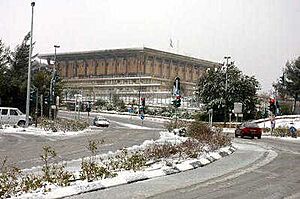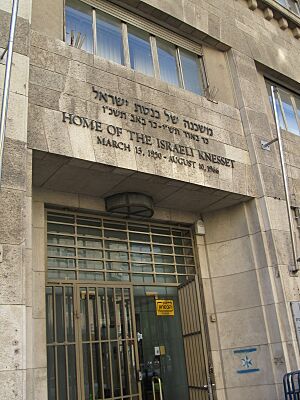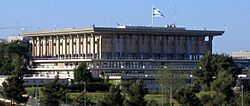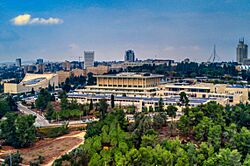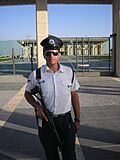Knesset facts for kids
Quick facts for kids The Knessetהכנסת الكنيست |
|
|---|---|
| 25th Knesset | |
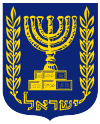 |
|
| Type | |
| Type | |
| Leadership | |
|
Leader of the Opposition
|
|
| Structure | |
| Seats | 120 |
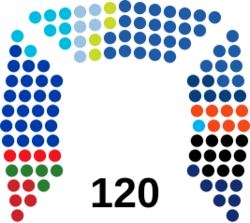 |
|
|
Political groups
|
Government (60)
Opposition (60)
|
| Elections | |
| Closed list proportional representation D'Hondt method with a 3.25% electoral threshold |
|
|
Last election
|
1 November 2022 |
|
Next election
|
On or before 27 October 2026 |
| Meeting place | |
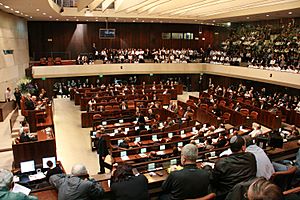 |
|
| Knesset building, Givat Ram, Jerusalem | |
The Knesset (pronounced Ha-KNEH-set) is like the parliament or main law-making body of Israel. The word "Knesset" means "gathering" or "assembly" in Hebrew. It's a special kind of parliament because it has only one main group of members.
The Knesset has many important jobs. Its members create and pass all the laws for Israel. They also choose the country's President and Prime Minister. The Knesset approves the government's team, called the Cabinet, and makes sure the government is doing its job well. It can even decide to hold new elections if needed. The Knesset meets in a special building in Givat Ram, a part of Jerusalem. People from all over Israel vote to choose the 120 members of the Knesset.
Contents
- The Name of the Knesset
- A Brief History of the Knesset
- How the Knesset Governs Israel
- Knesset Committees: Working Together
- Knesset Caucuses: Groups with Shared Interests
- Knesset Membership: Who are the Members?
- Knesset Elections: How Members are Chosen
- Current Knesset Members
- Knesset Assemblies: Numbered Sessions
- Visiting the Knesset
- Knesset Security: The Knesset Guard
- See also
The Name of the Knesset
The name "Knesset" comes from an old Jewish assembly called the "Great Assembly". This ancient group had 120 wise people and prophets. Today's Knesset also has 120 members, but it's a modern, elected body. A male member of the Knesset is called a Haver HaKnesset. A female member is a Havrat HaKnesset.
A Brief History of the Knesset
The Knesset first met on February 14, 1949, in Jerusalem. It took over from earlier groups that helped govern Israel. Before its current home, the Knesset met in Tel Aviv. Later, it moved to the Froumine building in Jerusalem.
The main Knesset building, where it is today, is on a hill in western Jerusalem. A generous gift from James de Rothschild helped build it. It was finished in 1966. Over the years, more parts were added to the building. These additions were designed not to change the look of the original structure. Sometimes, governments in Israel have faced votes where members show if they still support the government. If a government loses this vote, it might have to resign or new elections could be called.
Knesset Timeline: Key Dates
- 14 February 1949: The first meeting of the Constituent Assembly in Jerusalem.
- 16 February 1949: The name "Knesset" was approved. The number of members was set at 120. The Knesset started meeting in Tel Aviv.
- 26 December 1949 – 8 March 1950: The Knesset moved to Jerusalem. It first met at the Jewish Agency building.
- 13 March 1950: The Knesset moved to the Froumine House on King George Street in Jerusalem.
- 1950–1955: Plans were made for a permanent Knesset building.
- 1957: James de Rothschild offered to pay for the new building.
- 14 October 1958: The first stone was laid for the new Knesset building.
- 30 August 1966: The new building was officially opened.
- 1981: Construction began on a new section of the building.
- 1992: The new section opened.
- 2001: Construction started on a large new wing. This wing almost doubled the size of the Knesset area.
- 2007: The large new wing opened.
How the Knesset Governs Israel
The Knesset is the part of the Israeli government that makes laws. It creates all the country's laws. It also chooses the President and approves the government's team, called the Cabinet. The Knesset watches over the government's work using special groups called committees. It can also remove its own members' special protections if needed. The Knesset can even decide to end its own term and call for new elections.
The laws that guide how the Knesset works are called "Basic Laws." These are very important laws for Israel. The main leader of the Knesset is called the Speaker. There are also Deputy Speakers who help lead the meetings.
| Position | Name | Faction | Party |
|---|---|---|---|
| Speaker | Amir Ohana | Likud | Likud |
| Deputy | Nissim Vaturi | Likud | Likud |
| Deputy | Meir Cohen | Yesh Atid | Yesh Atid |
| Deputy | Hanoch Milwidsky | Likud | Likud |
| Deputy | Erez Malul | Shas | Shas |
| Deputy | Evgeny Sova | Yisrael Beiteinu | Yisrael Beiteinu |
| Deputy | Moshe Solomon | Religious Zionist Party | Religious Zionist Party |
| Deputy | Orit Farkash-Hacohen | National Unity Party | National Unity Party |
| Deputy | Moshe Roth | United Torah Judaism | Agudat Yisrael |
Knesset Committees: Working Together
The Knesset has many special groups called committees. These committees help change and improve new laws. Each committee focuses on a different topic, like money, education, or health. Members of the Knesset join these committees. They also choose leaders for each committee. Committees can ask government ministers and experts for information to help them make good decisions.
There are different kinds of committees. Some are permanent, meaning they work all the time on specific topics. Others are special committees created for certain issues. There's also an Ethics Committee. It makes sure that Knesset members follow the rules of good behavior. If a member breaks these rules, the Ethics Committee can take action. However, it cannot stop a member from voting. Another important group is the Arrangements Committee. It helps decide how the other committees are set up after each election.
Permanent Committees
- House Committee
- Finance Committee
- Economic Affairs Committee
- Foreign Affairs and Defense Committee
- Interior and Environment Committee
- Immigration, Absorption, and Diaspora Affairs Committee
- Education, Culture, and Sports Committee
- Constitution, Law and Justice Committee
- Labor, Welfare and Health Committee
- Science and Technology Committee
- State Control Committee
- Committee on the Status of Women
Special Committees
- Committee on Drug Abuse
- Committee on the Rights of the Child
- Committee on Foreign Workers
- Central Elections Committee
- Public Petitions Committee
Knesset members often join formal or informal groups. These groups are called "lobbies" or "caucuses". They work together to support a particular topic or cause. There are hundreds of such caucuses in the Knesset. Examples include the Knesset Christian Allies Caucus and the Knesset Land of Israel Caucus.
Knesset Membership: Who are the Members?
The Knesset has 120 members. This number is based on the ancient Great Assembly. Sometimes, a Knesset member becomes a government minister. Under a rule called the "Norwegian Law," they can resign their seat. This allows the next person on their party's list to take their place. If they stop being a minister, they can return to the Knesset.
Knesset Elections: How Members are Chosen
Every four years, or sometimes sooner, people in Israel vote for the 120 members of the Knesset. Anyone 18 years or older can vote in these elections. The voting is secret. The seats in the Knesset are given to different political parties based on how many votes they get. This system is called proportional representation. A party needs to get at least 3.25% of all the votes to win any seats. People vote for a party, not for individual candidates.
Because many parties usually win seats, no single party has ever won enough seats to have a majority on its own. This means that different parties often have to work together to form a government. These are called coalition governments. After an election, the President talks to the leaders of all the parties. The President then chooses the party leader who seems most likely to get enough support to form a government. This person then has time to build a team and must get the Knesset's approval before becoming Prime Minister.
List of Knesset Elections
- 1949 Israeli Constituent Assembly election
- 1951 Israeli legislative election
- 1955 Israeli legislative election
- 1959 Israeli legislative election
- 1961 Israeli legislative election
- 1965 Israeli legislative election
- 1969 Israeli legislative election
- 1973 Israeli legislative election
- 1977 Israeli legislative election
- 1981 Israeli legislative election
- 1984 Israeli legislative election
- 1988 Israeli legislative election
- 1992 Israeli legislative election
- 1996 Israeli general election
- 1999 Israeli general election
- 2003 Israeli legislative election
- 2006 Israeli legislative election
- 2009 Israeli legislative election
- 2013 Israeli legislative election
- 2015 Israeli legislative election
- April 2019 Israeli legislative election
- September 2019 Israeli legislative election
- 2020 Israeli legislative election
- 2021 Israeli legislative election
- 2022 Israeli legislative election
Current Knesset Members
The table below shows the political groups in the 25th Knesset.
| Name | Main Ideas | Symbol | Primary Group | Leader | 2022 result | ||
|---|---|---|---|---|---|---|---|
| Votes (%) | Seats | ||||||
| Likud | Conservative and nationalist ideas | מחל | – | Benjamin Netanyahu Prime Minister of Israel |
23.41% |
32 / 120
|
|
| Yesh Atid | Liberal and secular ideas | פה | – | Yair Lapid Leader of the Opposition |
17.78% |
23 / 120
|
|
| Otzma Yehudit | Nationalist ideas | ט | – | Itamar Ben-Gvir Minister of National Security |
10.83% |
7 / 120
|
|
| Mafdal – Religious Zionism | Religious Zionist ideas | Israeli settlers, Modern Orthodox and Hardal Jews | Bezalel Smotrich Minister of Finance |
6 / 120
|
|||
| Noam | Religious conservative ideas | – | Avi Maoz |
1 / 120
|
|||
| National Unity | Zionist ideas | כן | – | Benny Gantz | 9.08% |
12 / 120
|
|
| Shas | Religious conservative ideas | שס | Sephardi and Mizrahi Haredim |
Aryeh Deri | 8.24% |
11 / 120
|
|
| United Torah Judaism | Religious conservative ideas | ג | Ashkenazi Haredim | Yitzhak Goldknopf | 5.88% |
7 / 120
|
|
| Yisrael Beiteinu | Nationalist, secular, and conservative ideas | ל | Russian-speakers | Avigdor Lieberman | 4.49% |
6 / 120
|
|
| Ra'am | Islamic and conservative ideas | עם | Israeli Arab Sunni Muslims, Negev Bedouin | Mansour Abbas | 4.07% |
5 / 120
|
|
| Hadash–Ta'al | Focus on Israeli Arab interests and secular ideas | ום | Israeli Arabs | Ayman Odeh | 3.75% |
5 / 120
|
|
| Labor | Zionist, progressive, and secular ideas | – | Yair Golan | 3.69% |
4 / 120
|
||
Knesset Assemblies: Numbered Sessions
Each time a new Knesset is elected, it gets a number. For example, the first Knesset was elected in 1949. The current Knesset, elected in 2022, is the Twenty-fifth Knesset.
- 1st (1949–1951)
- 2nd (1951–1955)
- 3rd (1955–1959)
- 4th (1959–1961)
- 5th (1961–1965)
- 6th (1965–1969)
- 7th (1969–1974)
- 8th (1974–1977)
- 9th (1977–1981)
- 10th (1981–1984)
- 11th (1984–1988)
- 12th (1988–1992)
- 13th (1992–1996)
- 14th (1996–1999)
- 15th (1999–2003)
- 16th (2003–2006)
- 17th (2006–2009)
- 18th (2009–2013)
- 19th (2013–2015)
- 20th (2015–2019)
- 21st (2019)
- 22nd (2019–2020)
- 23rd (2020–2021)
- 24th (2021–2022)
- 25th (2022–)
Visiting the Knesset
The Knesset offers morning tours in several languages. These include Hebrew, Arabic, English, French, Spanish, German, and Russian. Tours are available on Sundays and Thursdays. You can also watch live sessions on Monday, Tuesday, and Wednesday mornings.
Knesset Security: The Knesset Guard
The Knesset building and its members are protected by the Knesset Guard. This is a special security unit. Guards stand outside the building to provide armed protection. Ushers work inside to keep order. The Knesset Guard also takes part in important national ceremonies. This includes greeting special guests on Mount Herzl during Israeli Independence Day.
See also
 In Spanish: Knéset para niños
In Spanish: Knéset para niños
- Great Assembly
- Elections in Israel
- Politics of Israel
- Knesset Guard
- Knesset Legal Adviser
- List of Arab members of the Knesset
- Lists of Knesset members
- List of Knesset speakers
- List of legislatures by country



